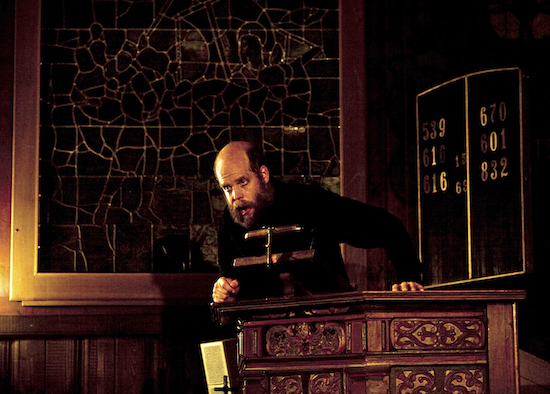From the simple white text appearing on a black screen, to the delicate underscore provided by Will Oldham and Emmett Kelly, the gentle pace of The Royal Dutch Tour Documentary is firmly established from the first few moments. This is no fast and loose road movie; Italian film-maker Simona Dalla Valle’s debut is a quietly observational and yet intimate documentary about a minor tour that took place in a series of small venues in Holland in the September of 2014.
Featuring a band of minstrels comprising Will Oldham (Bonnie Prince Billy), Emmett Kelly (The Cairo Gang) and Dutch natives Tonnie ‘Broeder’ Dieleman and Leo Meijer, The Royal Dutch Tour Documentary is dubbed a ‘fusion film’ by Dalla Valle. Combining culture, place and music, it was made in a binary structure, inspired by Michael Winterbottom’s film Nine Songs and rolls out in chapter format, highlighting the history of the venue followed by footage from that night’s performance.
While it might seem like an unusual approach, this binary fusion, as Dalla Valle reveals, "was the only possible film that could have resulted from that tour". A case where necessity was the mother of invention because while Oldham eventually agreed to let Dalla Valle film him on tour, he imposed strict limitations which meant she could only feature the musicians while they were performing. Everything else was off limits.
Working alone, Dalla Valle was able to slide in like part of the gang, and join the musicians on their tiny tour. As a result, the film is an unobtrusive portrait of peace and harmony. Oldham said "this here is a film that contextualizes a musical trip in a completely new way. As a musical participant in the documented trip, it’s a joy to see the outside of what I had experienced from deep inside, and even more of a joy to know that such a great adventure is so memorialized, with necessary grace and beauty".
The action begins with Chapter One, and some picturesque imagery from a town called Middelburg. Dalla Valle’s eye for beauty becomes evident immediately. Each shot is framed beautifully, and she manages to capture the smallest quirks and character-filled points of interest in the locations through which she roams. Her roving camera drops in on a carved stone ship on a lintel and an angelic sculpture peering over the edge of a rooftop, if only she lingered a little longer on these delightful details.
Our first ‘tour guide’, writer Alice Anna Verheij, talks us through the trade city of Middelburg, giving us a brief history of the town and the damage caused by WWII. We get a brief look at the first performance as folk musician Tonnie "Brother" Dieleman sings a cappella. But it soon cuts to Dieleman taking his turn as tour guide, introducing the Kapel van Hoogelande, which then leads into that evening’s performance.
‘Troublesome Houses’ is the first track by Oldham and Kelly. In the dimly flickering candlelight, the visual contrast is high and it’s difficult to see the faces, but nonetheless it’s a captivating performance and an affirmation of Oldham’s pure joy in song.
From Middelburg we move on to the Doopsgezinde church of Utrecht built in 1773. As caretaker Jan Van Strien describes the Mennonite church’s history, Dalla Valles takes us on a visual tour of the rich, dark timber decor highlighting the stark, austere whiteness of the walls and teasing us with glimpses of the more decorative emerald tiles and a stately organ. Dieleman sings ‘Adriana’ barefoot with his guitar as Meijer plays harmonium which is followed by Oldham/Kelly performing a heartbreaking version of ‘With Cornstalks Or Among Them.’
The narrative cycles of this film contribute to the measured pace; knowing what comes next provides a type of comfort. The crisp, day-lit interviews with the writers, artists, priests, teachers and caretakers inform you about the venue but they also give you a feeling for the people of the town. The accents, the dress and the assumptions made, all add to the cultural layers like a living mise-en-scene. We get to feel, just a little bit, what it might have been like on tour with Oldham and his troupe, discovering these charming villages, and meeting the local characters.
Each chapter covers a location from the tour, and takes us on a journey to Zwolle, Nijmegen, Rotterdam, Winsum and Amsterdam, mostly to churches in small villages. One of the most memorable locations is the Norwegian Sailor’s Church in Rotterdam, made entirely of Norwegian wood; adorned in bold and colourful folk art. This venue also yields a particularly well-lit and dynamic performance of ‘Go Folks, Go.’
Featuring tracks mostly from the 2010 collaboration The Wonder Show Of The World, it’s pure indulgence to witness these songs lovingly re-interpreted in an array of intimate venues. The final scene presents a collection of footage from the final shows in Amsterdam’s Roode Bioscoop and includes a lovingly raw version of ‘Lion Lair’, a beautifully paired back cover of The Everly Brothers’ ‘I Wonder If I Care As Much’ and closes with ‘Kids’.
A big part of the charm of The Royal Dutch Tour Documentary is its refreshing slowness and simplicity. There’s no tricky camera work, no fancy scoring, no treatments or effects. This is honest film-making at its humble best. The unpretentious, straight-forward execution of this independent film, despite the cause, fits comfortably with Oldham’s modus operandi and also with that of the Dutch people who are known for their modest practicality and directness.
Defined by its limits, The Royal Dutch Tour Documentary illustrates what’s possible when an idea, a tour and a testimony flourishes within the given boundaries. This is by no means a perfect film but it is perfectly complete in itself.
The Royal Dutch Tour Documentary is screening at 18:30 Monday 7th November as part of Doc’n’Roll Film Festival, at Picturehouse Central.
Tickets available here


